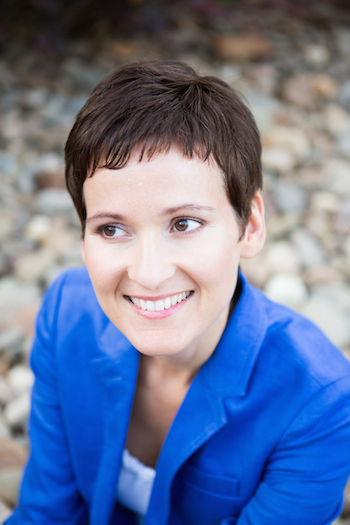Yoga for Natural Childbirth
This post was written by H&W instructor Ginger Garner, MPT, ATC, PYT. Ginger will be instructing the course that she wrote on "Yoga as Medicine for Labor and Delivery and Postpartum" in Washington this August.
Note: This post is for colleagues, patients, and friends whose greatest desire is to have a healthy baby via natural childbirth. In this article, natural childbirth refers to an unmedicated delivery of your baby, assisted with natural, non-pharmaceutical means. While not all women have the luxury of natural childbirth, and some choose other means, please know that Ginger’s course supports all women and their personal decisions about birth.

My first natural birth was December 27, 2005. After a long, hard labor that started on Christmas, my son Michael arrived safe and healthy into my arms.
But something was missing.
I could have better prepared for birth. Bradley technique had reinforced that yoga was a wonderful way to relax and give into the sensations of contractions. Prenatal Pilates and walking, along with yoga, had also provided me with the endurance to go the long 36-hour distance during labor.
What was missing was my active, deliberate, and planned participation during birth.
A birth plan helps to organize your thoughts, but a mother needs her own, personal birth plan too. After Michael’s birth, I began to create my own future personal birth plan, which also changed the way I saw, and helped, my own prenatal patients.
That personal birth plan carried me beautifully (and with less pain and more control) through my next two births, William and James. An n of 2 (subject size of 2, in research terms) was small, but very soon after science began investigating the actual effects of using yoga for childbirth preparation and actual labor and delivery. The results are very promising, as I’ll discuss below.
Expectant women should work directly with an experienced physical therapist to create their own personal birth plan based on their individual mind-body needs. Mind-body needs should consider the following variables:
- Physical Labor Needs: Adapt labor and birth positions based on the patient’s specific orthopaedic injuries or aches and pains that can prevent focus or certain positioning during birth. This could include but is not limited to problems like hip impingment, shoulder impingement, sacroiliac joint pain, back pain, limitations in ROM, or existing pelvic pain.
- Psychoemotional/Physical Labor Needs: Consider previous birth trauma or history such as prior C-section, episiotomy, or difficulty with pain management or dilation that may affect labor progression.
- Psychoemotional/Energetic/Spiritual Labor Needs: Establish adequate birth support during labor. A 2012 Cochrane review of RCT’s found that women with continuous support were more likely to have a spontaneous vaginal birth, less likely to have pain medications, epidurals, negative feelings about childbirth, vacuum or forceps-assisted birth, and C-sections. Women with support also had shorter labors by 40 minutes, higher APGAR scores, and the best overall outcomes. Constant support means a mother has someone continuously at her side during the entirety of labor. That person must also be an active, knowledgeable participant in the labor process, not just a warm body taking up space.
- Intellectual Labor Needs: Educate the mother and her birth partner about how to execute the personal birth plan, which can include yogic breathing, a bevy of yoga posture options for individualized labor and birth positions, guided imagery and/or motor imagery techniques, and hands-on manual therapy techniques.
- Psychoemotional/Energetic Labor Needs: Address any previous birth or sexual trauma which could create anxiety and fear. Anxiety and fear of childbirth can prolong labor more than 90 minutes (Adams et al 2012).
Yoga is an amazing, proven method to directly diminish perceived pain during labor, immediate postpartum pain, and shorten labor duration, as well as improve maternal comfort and birth outcome scores, as found in a 2008 randomized trial of 78 pregnant Thai women.
Ginger’s course, Yoga as Medicine for Labor, Delivery, and Postpartum prepares the physical therapist to meet the needs of the laboring mother with an evidence-based mind-body holistic perspective, which includes designing individualized birth plans for labor and delivery. Future posts will also address the postpartum curriculum included in the course. To learn more about Ginger’s course, visit Yoga as Medicine for Labor, Delivery, and Postpartum.
By accepting you will be accessing a service provided by a third-party external to https://hermanwallace.com/









































